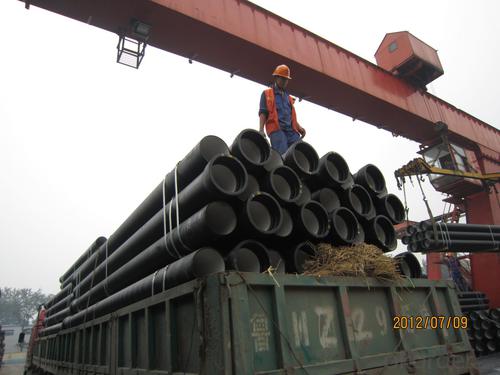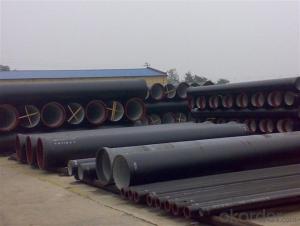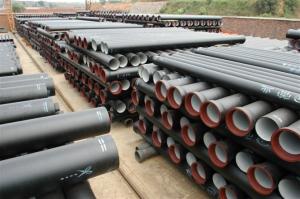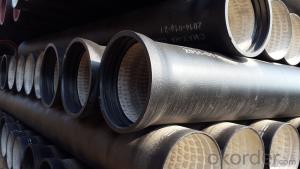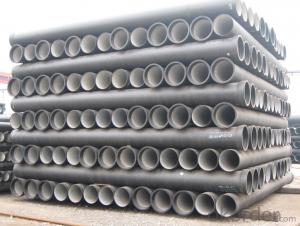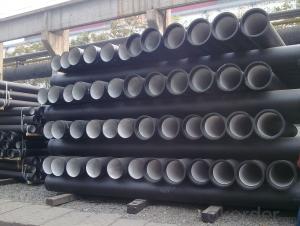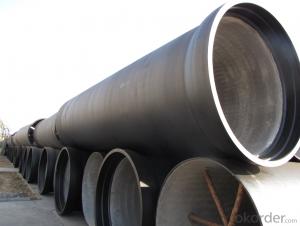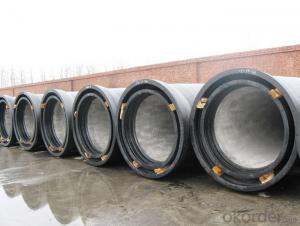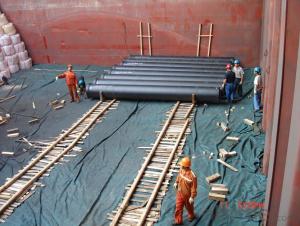Ductile Iron Pipe DN150
OKorder Service Pledge
OKorder Financial Service
You Might Also Like
Specifications
Quick Details
| Place of Origin: | China (Mainland) | Brand Name: | CMAX | Model Number: | T type / K type / Flange type |
| Length: | 6m / 5.7m / Negotiable | Standard: | ISO2531 / EN545 / EN598 | Application: | Potable / Sewage water |
| Diameter: | DN80~DN2200 | Shape: | Round | Hardness: | 230 |
| Pipe Wall Thickness: | standard | Pull Strength: | 420 | Yield (≥ MPa): | 300 |
| Material: | Ductile Iron | Type: | Centrifugal ductile cast iron pipe | Certification: | ISO2531 / EN545 / EN598 |
| Outer Diameter: | 80-2200 | Thickness: | standard | Specification: | DN80~DN2200 |
| |
The advantages to the customer:
Trustworthy financial strength.
One-stop shopping.
Fast and efficient service.
Coordination of shipments from multiple plants.
Specialists of the overseas shipping process.
A more competitive price.
Ductile iron pipe is sized according to a dimensionless term known as the Pipe Size or Nominal Diameter (known by its French abbreviation, DN). This is roughly equivalent to the pipe's internal diameter in inches or millimeters. However, it is the external diameter of the pipe that is kept constant between changes in wall thickness, in order to maintain compatibility in joints and fittings. Consequently the internal diameter varies, sometimes significantly, from its nominal size. Nominal pipe sizes vary from 3 inches up to 64 inches, in increments of at least 1 inch, in the USA.
Pipe dimensions are standardised to the mutually incompatible AWWA C151 (U.S. Customary Units) in the USA, ISO 2531 / EN 545/598 (metric) in Europe, and AS/NZS 2280 (metric) in Australia and New Zealand. Although both metric, European and Australian are not compatible and pipes of identical nominal diameters have quite different dimensions.
Flanges are flat rings around the end of pipes which mate with an equivalent flange from another pipe, the two being held together by bolts usually passed through holes drilled through the flanges. A deformable gasket, usually elastomeric, placed between raised faces on the mating flanges provides the seal. Flanges are designed to a large number of specifications that differ because of dimensional variations in pipes sizes and pressure requirements, and because of independent standards development. In the U.S. flanges are either threaded or welded onto the pipe. In the European market flanges are usually welded on to the pipe. In the U.S. flanges are available in a standard 125 lb. bolt pattern as well as a 250 lb (and heavier) bolt pattern (steel bolt pattern). Both are usually rated at 250 psi (1,700 kPa). A flanged joint is rigid and can bear both tension and compression as well as a limited degree of shear and bending. It also can be dismantled after assembly. Due to the rigid nature of the joint and the risk of excessive bending moment being imposed, it is advised that flanged pipework is not buried.
Current flange standards used in the water industry are ANSI B16.1 in the USA, EN 1092 in Europe, and AS/NZS 4087 in Australia and New Zealand.
Ductile iron pipe is somewhat resistant to internal corrosion in potable water and less aggressive forms of sewage. However, even where pipe material loss and consequently pipe wall reduction is slow, the deposition of corrosion products on the internal pipe wall can reduce the effective internal diameter. A variety of linings are available to reduce or eliminate corrosion, including cement mortar, polyurethane and polyethylene. Of these, cement mortar lining is by far the most common.
Polyurethane (Plastic wrap) marginally protects piping made of ductile cast iron against corrosion and ensures meeting hygienic standards for drinking water at the same time in the early years. Polyurethane is used for both the inside lining and the outside coating. Because of polyurethane's elasticity, the coating remains intact even if the pipe is deformed. A major problem is that the poly wrap is not able to be uniformly installed or even installed without rips and creates isolated corrosion attacks. Corrosion Experts
Polyurethane coatings were first used in 1972.[citation needed] In comparison with other coatings, the internal polyurethane lining exhibits a high resistance to various different media such as drinking water, wastewater, de-mineralised water, industrial water and gas, as well as to aggressive solutions such as sulphuric acid. The polyurethane outside coating is suitable for all kinds of soil.
Polyurethane is a thermosetting plastic with no solvents, with a three-dimensionally linked molecular structure giving it mechanical stability. The polyurethane used for conating has the following standard properties, according to EN 545 and ISO 2531 standards.
- Q: How do ductile iron pipes perform in high-temperature water applications?
- Ductile iron pipes perform well in high-temperature water applications due to their inherent strength and durability. They can withstand the elevated temperatures without losing their structural integrity, making them an ideal choice for conveying hot water.
- Q: What is the maximum operating pressure for ductile iron pipes?
- The maximum operating pressure of ductile iron pipes may vary based on factors like pipe diameter, wall thickness, and the specific usage. Nonetheless, typically, ductile iron pipes are engineered to endure pressures of up to 350 psi (pounds per square inch), and occasionally even higher. It is worth highlighting that to ascertain the precise maximum operating pressure for a specific ductile iron pipe system, one should refer to local regulations, engineering standards, and manufacturer specifications.
- Q: Can ductile iron pipes be used for underground steam distribution systems?
- Ductile iron pipes are well-suited for underground steam distribution systems. They belong to the cast iron family, but have been treated with magnesium to enhance their flexibility and resistance to cracking. Consequently, they can endure high pressure and temperature conditions, making them ideal for underground applications like steam distribution systems. The strength and durability of ductile iron pipes are remarkable, allowing them to withstand the extreme conditions associated with steam distribution. Moreover, their corrosion resistance properties make them a dependable choice for long-term use in underground environments. Nevertheless, it is essential to apply proper insulation to prevent heat loss and ensure the efficiency of the steam distribution system.
- Q: Can ductile iron pipe be used for pressure sewer systems?
- Ductile iron pipe is indeed suitable for pressure sewer systems. Renowned for its strength, durability, and corrosion resistance, ductile iron pipe finds application in various fields, including pressure sewer systems. It effortlessly withstands high-pressure environments, serving as a dependable conduit for pressurized wastewater transportation. Furthermore, its exceptional joint integrity ensures leak-free connections and mitigates the possibility of sewer system breakdowns. Consequently, ductile iron pipe is widely employed in pressure sewer systems due to its unwavering structural integrity and extended lifespan.
- Q: What's the difference between cast iron pipe and steel pipe?
- Cast iron pipes (Cast, Iron, Pipe), cast cast pipe. Cast iron pipes are used for water supply, drainage and gas transmission lines. They include cast iron pipes and pipe fittings. Labor intensity is small. According to the casting method, it is divided into continuous cast iron pipe and centrifugal cast iron pipe, in which the centrifugal cast iron pipe is divided into sand mould and metal type two kinds. Divided into gray cast iron pipe and nodular cast iron pipe according to different material. According to the interface form, it is divided into flexible interface, flange interface, self anchored interface, rigid interface and so on. Among them, the flexible iron pipes rubber sealing ring; flange interface cast iron pipe flange fixed in the rubber pad, the flange gasket sealing; rigid interface cast iron pipe socket is large, straight pipe is inserted, sealed with cement, this technology has been basically eliminated
- Q: Can ductile iron pipes be used for underground drainage systems?
- Indeed, underground drainage systems can utilize ductile iron pipes. Ductile iron, being a robust and enduring substance, exhibits resistance to corrosion, rendering it appropriate for subterranean applications. Possessing remarkable tensile strength, it can endure substantial loads and pressures, thereby making it an excellent choice for drainage systems that encounter significant flow rates or necessitate substantial burial depths. Moreover, ductile iron pipes boast an extended lifespan, thereby decreasing the requirement for frequent maintenance or replacement. All in all, ductile iron pipes prove to be an unwavering and efficient option for underground drainage systems.
- Q: How do ductile iron pipes handle concentrated loads?
- Ductile iron pipes are designed specifically to effectively handle concentrated loads. Their unique composition and manufacturing process give them excellent strength and durability, making them highly resistant to cracking or breaking under heavy loads. One of the main features of ductile iron pipes is their high tensile strength, allowing them to withstand concentrated loads without deforming. During the production process, small amounts of magnesium are added to cast iron, transforming the brittle graphite flakes into nodular graphite. This modification greatly enhances the material's strength and ductility, enabling it to handle concentrated loads more effectively. Furthermore, ductile iron pipes have a high modulus of elasticity, meaning they can deform elastically under a load and then return to their original shape once the load is removed. This property allows the pipes to evenly distribute the concentrated load along their entire length, reducing stress concentrations and minimizing the risk of fractures or failures. Additionally, ductile iron pipes have a thick and robust wall thickness, ensuring exceptional structural integrity. This thickness enables the pipes to bear significant loads and withstand pressure variations without compromising their overall performance. In conclusion, ductile iron pipes are engineered specifically to handle concentrated loads due to their high tensile strength, elastic deformation capabilities, and thick wall thickness. These characteristics make them a reliable choice for a variety of applications, including water and wastewater systems, as they can withstand external forces without compromising their structural integrity.
- Q: Usage of ductile iron pipe expander
- Usage of ductile iron pipe expander:1, the expansion device should check its type, specification and piping configuration before installation, must comply with the design requirements.2, the expansion of the inner sleeve should be noted that the direction of the inner sleeve is consistent with the direction of the medium flow. The hinge rotation plane of the hinge type telescopic device should be consistent with the displacement rotation plane.3, the need for "cold tight" expansion device, pre deformation of the auxiliary components should be installed in the pipeline before they can be removed.4, it is strictly prohibited to use telescopic deformation method to adjust the installation of the pipe, so as not to affect the normal function of the telescopic device, reduce the service life and increase the piping, equipment and supporting components of the load.5 、 during installation, welding slag is not allowed to splash to the surface of wave shell, and the wave shell is not allowed to suffer other mechanical damage.6, pipe installation is completed, should be removed as soon as the wave expansion device used for installation and transportation of yellow auxiliary positioning components and fasteners, and according to the design requirements will be transferred to the specified position limiting device, the pipe system has the ability to compensate fully in the environmental conditions.
- Q: Method for cutting large diameter ductile iron pipe
- When the oxygen and acetylene volume ratio is greater than 1.2, is formed. As more oxygen, burning, the flame length is shortened obviously, cone tapered inner flame almost disappeared, and a strong desire. Making due to oxygen, the oxidation of metal, so are not widely used, only used for welding of brass, to prevent evaporation of zinc.
- Q: Can ductile iron pipes be used for irrigation pivot systems?
- Yes, ductile iron pipes can be used for irrigation pivot systems. Ductile iron pipes are known for their strength, durability, and resistance to corrosion, making them suitable for various applications including irrigation. These pipes can withstand high water pressure and provide a reliable and long-lasting solution for transporting water to irrigation pivot systems. Additionally, ductile iron pipes are also compatible with various fittings and connectors commonly used in irrigation systems, making them easy to install and maintain. Overall, using ductile iron pipes for irrigation pivot systems is a practical choice that ensures efficient water distribution and minimizes the risk of pipe failure.
Send your message to us
Ductile Iron Pipe DN150
OKorder Service Pledge
OKorder Financial Service
Similar products
Hot products
Hot Searches
Related keywords


